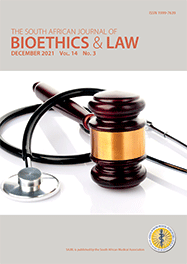The ethics of claiming a 60% reduction in HIV acquisition from voluntary medical male circumcision
To the Editor: Dr Masukume1 recommends that we avoid using the relative risk reduction (RRR) statistic in counselling men on the benefits of voluntary medical male circumcision (VMMC). He makes the following important points that epidemiologists frequently emphasise: RRR is a measure of association that is difficult for patients to understand and a different statistic, i.e. number needed to treat (NNT) (or in this case, number needed to prevent HIV infection), is often a preferable statistic to use when counselling patients about any medical intervention.2
There is a good reason why RRR has historically been used as a shorthand in communicating the risks and benefits of medical interventions. The RRR is stable over wide variations in the risk of the population being studied, while the NNT varies widely with risk. For example, the three large randomised controlled trials of VMMC in Africa each showed a similar reduction in risk of HIV acquisition, but the NNT varied substantially according to the population studied (Table 1).
The advantage to using RRR, and the reason why it has historically been used, is because it is simple. RRR remains relatively constant; there is, therefore, ‘one number’ that we can quote when counselling patients. As we can see from Table1 below, there is not one number for RRR; rather, it varies widely depending on the baseline risk. HIV incidence rates vary substantially by country, over time, and even more widely by community and demographic/risk characteristics of the individual patient. Therefore, we would ideally have to individualise the NNT for each patient. We might say that a 20-year-old single man with multiple sexual partners would be much more likely to benefit (a low NNT) than a 50-year-old married man from the same geographical area (a high NNT).
When communicating with patients, we try to keep things as simple and straightforward as possible. While the NNT does have well-recognised benefits over RRR, it is certainly hyperbole to call use of the RRR statistic ‘unethical’.
Peter S Millard
Adjunct Professor, Graduate Programme in
Public Health,
University of New England, Maine, USA
pmillard@mac.com
References
- 1. Masukume G. The
ethics of claiming a 60% reduction in HIV acquisition from
voluntary medical male circumcision. South African Journal of
Bioethics and Law 2014;7(1):4. [http://dx.doi.org/10.7196/sajbl.313]
- 2. Cook RJ,
Sackett DL. The number needed to treat: A clinically useful
measure of treatment effect. BMJ 1995(2);310:452-454.
[http://dx.doi.org/10.1136/bmj.310.6977.452]
Article Views
Full text views: 3904



.jpg)
Comments on this article
*Read our policy for posting comments here